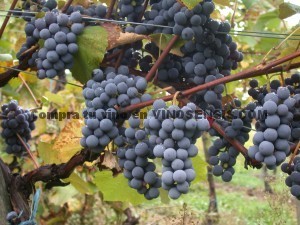Introduction
The name Tempranillo comes from the diminutive of Temprano (Early in Spanish), and refers to the fact that the grapes ripen several weeks earlier than many other varieties found on the Spanish territory. This variety is considered by many as the noble grape of Spain.
Origins
For many years it was believed that the Tempranillo grape was related to Pinot Noir. But recent studies of its genetic code have proven that Tempranillo is an independent grape, having no relationship with Pinot Noir.
Where does it grow?
Tempranillo is the king of grapes in Spain and is located in almost the whole of the Iberian Peninsula, under various names like Ull de Llebre in Catalonia or Tinto del Pais.
The two most important regions of Spain for Tempranillo are Rioja, in north-central Spain and the Ribera del Duero, located a little further south-west. Tempranillo is the main grape of Rioja, where a typical mixture contains 90-100% and is also present in wines from Ribera del Duero. Significant quantities are also grown in the regions of Penedès, Navarra and Valdepeñas. In addition, you can find it in almost every denomination of Spanish origin, such as: Almansa, Calatayud (4%), Campo de Borja (11%), Carignan (15%) Cigales Conca de Barberà Costers del Segre, Jumilla, La Mancha, Méntrida, Navarra (15%), Penedes, Rioja, Ribera del Duero, Somontano Valdepeñas (13%) and de Vinos de Madrid (5%).
In the early 20th century (1905), Frederick Bioletti brought the Tempranillo grape to California (USA) where its adoption by local producers has been complicated by the characteristics of the grapes, which do not grow well under conditions of hot and dry climate. Later, during the 1980s, the production of Tempranillo was developed following its relocation to most suitable land in mountainous areas.
The Tempranillo grape is experiencing a renaissance in the world. Following this “democratization” of this very Spanish, today we can find wine made from Tempranillo grapes in places as distant as Australia, Argentina, Chile, Peru, Uruguay, Mexico, the United States and South Africa.
Aromas
Although the grape provides some specific aromatic aspects, it is important to remember that the aromas of a wine are usually the result of the interaction between the grape, the weather, the terrain and the work of farmers. The wines made from Tempranillo often have fruity aromas of plum, tobacco, vanilla, leather and grass. You can also identify the notes of blackberry and licorice.
Colors
The wines from Tempranillo grapes tend to be bright red, like red rubies.
Synonyms
Aldepenas, Aragon, Aragones (Spain), Da Aragonez Ferra, Elva Aragon, Arganda, Arinto Tinto Cencibel (Castilla La Mancha, Madrid, Aragon, Extremadura, Murcia), Cencivera, Chinchillana (Extremadura), Chinchillano, Chinchillano, Cupana, Broom (Extremadura and South America), Garnacho Phone (South America), Garnacha de Logroño, Jacibiera (Castilla La Mancha, South America), Jacivera Juan Garcia, Black Mesa, Scammon, Olho de Lebre, sensibel Tempranillo, Tempranillo, Rioja, Tempranillo Perralta, Rioja Tempranillo, Tempranillo RIOZ, ink ink Santiago Aragones, Tinta de Toro Tinta Do Inacio, Monteiro, Monteiro ink, Tinta Roriz (Portugal), Tinta Roriz of Penajola , Tinta SantiagoAragón Tinto, Tinto Aragones Tinto Ribera, Tinto de Madrid (Toledo, Cantabria, Salamanca, Soria, Valladolid, Madrid), Tinto del Pais (Castile, Leon, La Rioja), Tinto de Rioja, Tinto de Toro (Zamora ), Tinto del Toro, Tinto Fino (Castile, Leon, Madrid, Valencia, Extremadura La Rioja), Tinto Pais Tinto Madrid Tinto Ribeira, Rioja Tinto, Ull de Llebre (Catalonia), Valdepeñas (California), Verdiell (Catalonia) Aranda Vid (Burgos), James ink (South America), Montereiro ink (South America).


